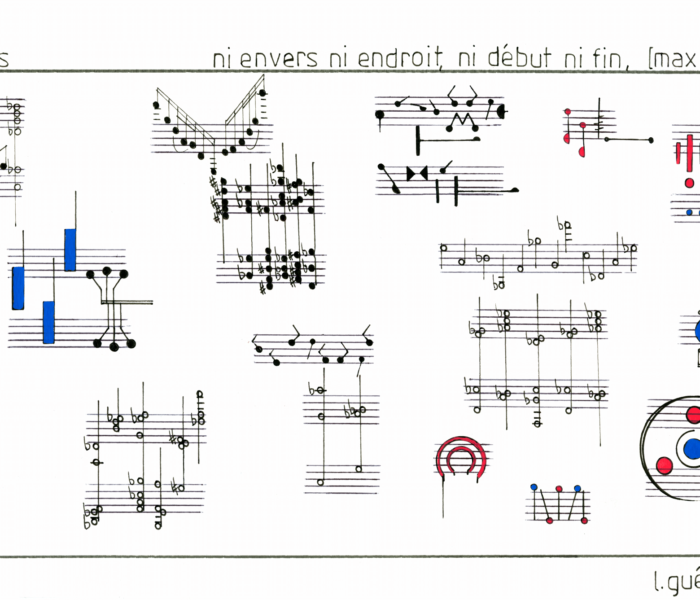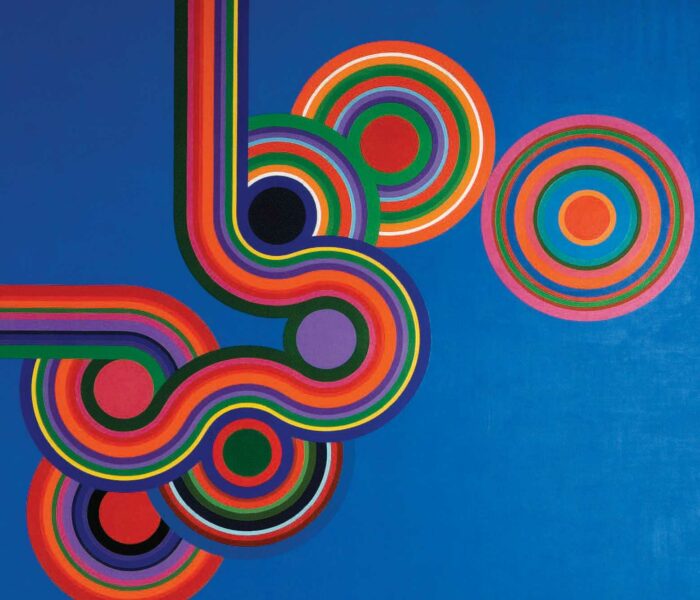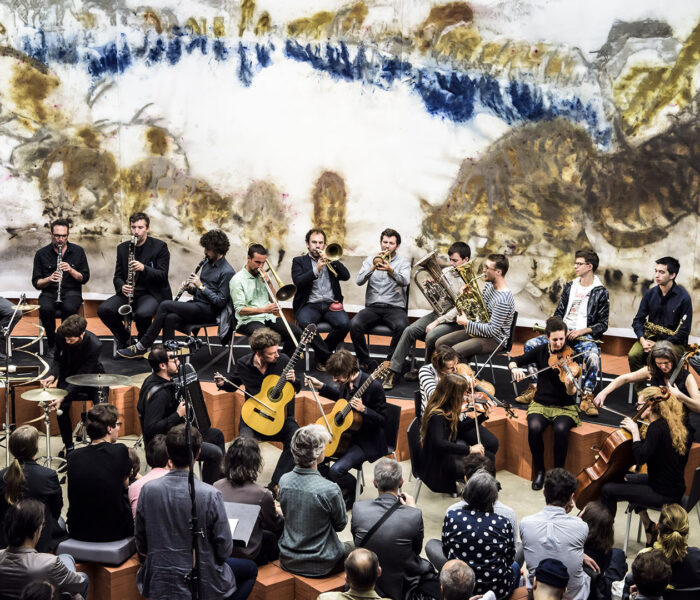Les multiples courants qui écrivent le présent des musiques de création excèdent largement le seul champ de la musique écrite. Une réalité dont témoigne ce dossier, qui réunit les voix de musicien.nes et de musicologues de tous horizons autour de cette question de l’écriture.
Le présent de la musique n’est pas forcément un présent de l’écriture. Force est de reconnaître qu’en 2022, le champ des musiques de création contemporaines excède largement celui de la seule musique dite, précisément, « contemporaine » – sous-entendu : écrite. L’existence d’Hémisphère son en témoigne, de même d’ailleurs que le parcours de ses contributrices et contributeurs, qui ont en commun d’avoir été biberonné.e.s à la musique occidentale de tradition écrite avant d’être transformé.e.s par leur contact avec de multiples mouvances musicales « non-savantes », et non écrites – le jazz ou la techno, la musique improvisée ou le post-punk, sans parler des traditions musicales extra-occidentales – et par leur fréquentation assidue de nombreux lieux et manifestations pas forcément estampillés « musique contemporaine ». Personnellement, c’est notamment à un festival de poésie sonore – Sonorités, à Montpellier – qu’en octobre 2007, j’eus la joie de vivre une épiphanie musicale grâce à l’ensemble ]h[iatus (alors formé depuis peu) : en trio, Martine Altenburger, Tiziana Bertoncini et Lê Quan Ninh interprétaient des oeuvres de James Tenney, Carl Ludwig Hüsch, Salvatore Sciarrino et Helmut Lachenmann en passant de l’une à l’autre au moyen d’intermèdes improvisés. Déjouant les pièges du rituel classique – ces applaudissements qui viennent intempestivement et périodiquement rompre le charme -, ce concert fut un pur moment de musique, conviant l’auditeur à ouvrir ses oreilles et à abandonner ses œillères tout en brouillant les repères entre le fixé et l’instantané, entre l’Œuvre et l’éphémère.
De l’ensemble ]h[iatus – et d’hiatus en général -, il est question à plusieurs reprises dans ce dossier dont la nécessité s’est naturellement imposée, tant l’écriture semble être un prisme pertinent pour aborder les mutations qui s’opèrent actuellement dans le champ musical. Pour questionner, également, à la fois « son rapport à l’instrument et à sa culture », comme le dit Lê Quan Ninh, au sujet de l’improvisation, dans un texte d’Anne Montaron qui témoigne de ces « parcours en eaux mêlées » que j’évoquais à l’instant – et qui rappelle combien la pratique de l’improvisation a de tout temps été, en Occident, consubstantielle à la composition (et pas uniquement pour les organistes, de Johann Sebastian Bach à Jean-Pierre Leguay ou Thierry Escaich). Avant que le temps et l’évolution des mentalités – une sacralisation toute romantique de l’Œuvre et de l’Artiste dont nous sommes encore largement tributaires aujourd’hui – n’en vienne à opérer des cloisonnements, des hiérarchies, des segmentations qui perdurent encore dans les structures institutionnelles, et dans l’inconscient de maints musiciens.
Œuvres sans partition
Aujourd’hui toutefois, du moins à en croire les multiples artistes interrogé.e.s dans ce dossier, il semblerait que les frontières semblent redevenir poreuses, dans la réalité des pratiques du moins, sinon dans les structures institutionnelles. C’est le résultat combiné de facteurs à la fois endogènes et extérieurs au champ de la musique « savante », et dont la nature est esthétique autant que technologique.
Guillaume Kosmicki revient sur ces évolutions, et sur la manière dont la tabula rasa de l’après-guerre a conduit maints compositeurs, dans un désir de renouvellement esthétique, à explorer l’« au-delà de l’écriture » de multiples façons : partitions graphiques, recours à l’aléatoire, à l’improvisation. La figure de John Cage tient (une nouvelle fois) une place centrale, tant sa voie semble avoir marqué tous ceux qui l’ont croisée, de Karlheinz Stockhausen (et sa « musique intuitive ») à Meredith Monk, d’Éliane Radigue à John Luther Adams.
Ce dernier est l’un des compositeurs qu’évoque Makis Solomos dans un texte consacré à un autre phénomène essentiel : le « devenir-son » de la musique. C’est que dans le même temps, depuis 1945, se sont opérés, parallèlement aux évolutions du langage musical savant – qui ne sont pas allées sans leur lot de débats et de polémiques -, des bouleversements autrement plus structurels dans l’ensemble du paysage musical, largement tributaires des progrès techniques. L’après-guerre est la période qui, avec l’adoption du format LP et du 45 tours, assoit l’hégémonie du disque dans la diffusion de la musique : une hégémonie qu’a toujours favorisée l’engouement des mélomanes « classiques », mais qui capitalise surtout sur le succès des musiques populaires. Après le jazz, le triomphe du rock et des musiques amplifiées vient l’avènement du studio en tant qu’instrument : c’est une autre manière d’écrire la musique que de la coucher sur bande ; et c’est une nouvelle conception de l’oeuvre que celle de « l’album » (et non plus la partition), format qui, jusqu’à ce qu’internet ne vienne dématérialiser tout ça, demeurera le format canonique de la pop music.
C’est aussi l’époque de la « musique expérimentale » qui se développe dans le monde anglo-saxon, toujours dans le sillage de Cage : l’époque des œuvres fleuves de La Monte Young aux États-Unis et des partitions graphiques de Cornelius Cardew en Angleterre, Dans le même temps, les compositeurs de musique électroacoustique explorent une nouvelle manière d’écrire la musique, où la bande magnétique, le ruban adhésif et les ciseaux remplacent le papier, le crayon et la gomme, où les « sons fixés » tiennent lieu de notes. La partition s’avère un cadre parfois trop limitatif à l’aune de l’extension démesurée du domaine de la création sonore, et trop rigide pour restituer dans toute sa richesse la nouvelle nature des sons.
(Autant de démarches, soit dit en passant, qui montrent que le « non-écrit » n’équivaut pas automatiquement à l’improvisé ; la frontière entre le « fixé » et le « non fixé » étant de toute façon souvent bien difficile à circonscrire, comme le montre Ludovic Florin à partir de l’exemple de quelques musiciens de jazz contemporains. Son texte m’a fait songer au magnifique disque récemment publié par le percussionniste Didier Lasserre : Silence Was Pleased, qui vient « fixer » une « composition » d’abord pensée pour la scène. Associant autour de Lasserre un septuor d’improvisateurs virtuoses – Benjamin Bondonneau (clarinette), Christine Wodrascka (piano), Jean-Luc Cappozzo (trompette, bugle), Laurent Cerciat (voix d’alto), Gaël Mevel (violoncelle), Denis Cointe et Loïc Lachaize (traitements sonores) -, Silence Was Pleased est une pièce que l’on s’imaginerait très bien découvrir (avec enthousiasme) dans quelque salle de musique contemporaine : rigoureusement architecturée, témoignant d’une recherche sur les timbres étourdissante et souvent inouïe, elle n’en est pas moins mouvante à chaque exécution, malléable, perméable au contact du silence et au pouvoir de l’instant. Une œuvre, indéniablement, mais sans partition.
Au même titre d’ailleurs que l’illustre Köln Concert de Keith Jarrett, en l’occurrence une improvisation, mais que d’autres instrumentistes peuvent désormais s’approprier, grâce aux bons soins de ces transcripteurs dévoués auxquels le pianiste François Mardirossian rend hommage.
Et il faudrait aussi parler des autres traditions musicales, d’Asie, d’Afrique, d’Amérique du Sud, d’Europe ou du Moyen Orient, et en particulier des musiques de tradition orale et de la fonction qu’y occupe la partition. Dans la musique ottomane par exemple, comme le rappelle Kudsi Erguner, elle est avant tout un « aide-mémoire » – la notation (et l’organologie) occidentale traditionnelle peinant de toute façon à retranscrire la subtilité harmonique propre au maqâm. Concernant le folklore, on renverra aux éclairants ouvrages publiés par Denis Laborde sur le sujet (et en particulier le folklore basque) ; et l’on se bornera à constater que ces répertoires modestes, ces musiques souvent considérées comme « pauvres », dont seuls le collectage et l’enregistrement ont permis la survie, sont aujourd’hui l’objet d’une réappropriation hautement créative de la part d’artistes et instrumentistes venu.e.s de tous horizons musicaux, y compris des conservatoires, comme en témoigne par exemple le travail de collectifs tels que La Nòvia, Hart Brut ou La Crue.)
Gestes politiques
Toutes ces évolutions, naturellement, ont plus ou moins consciemment influencé les jeunes générations de musiciennes et de musiciens. On ne pense pas seulement aux progrès technologico-organologiques, et à l’apparition de l’ordinateur en tant qu’instrument, qui ont conduit à l’apparition de « partitions virtuelles » pour élargir la notation au champ des musiques « mixtes ».
On pense surtout, plus profondément, à la manière dont cette hégémonie de l’enregistrement et cette circulation mondialisée et instantanée de la musique ont imprégné nos esprits, transformé notre culture et notre sensibilité musicales, et ce faisant ont façonné de nouvelles visions de l’art musical et sonore, qui viennent brouiller les hiérarchies instituées. En donnant accès immédiatement à d’autres esthétiques, d’autres traditions, d’autres manières de fabriquer et de transmettre la musique, elles ont conduit à l’apparition d’un nouveau type de compositeur.trice, que l’on pourrait qualifier de « fluide » en référence à une rhétorique en vogue – la fluidité n’excluant pas la radicalité. L’opéra modeste de Myriam Pruvot, venue des Beaux-Arts et de la création radiophonique, comme les « partitions éphémères » de Mickaël Bernard convoquent une multiplicité de traditions musicales et de disciplines artistiques. Autant d’écritures du présent qui ne passent pas forcément par l’écriture au sens traditionnel du terme.
Cette liberté nouvelle vis-à-vis de la partition dénote aussi, en creux, un positionnement politique. Lorsque Loïc Guénin souligne que son approche « de la composition et du partage avec des interprètes » ne le place jamais « à l’endroit du sachant, du génie démiurge et intouchable qui maîtriserait la totalité des paramètres du son et ferait naitre la musique de son geste », ou lorsque les fondateurs de l’INSUB META ORCHESTRA parlent de leur ensemble comme d’« une micro-société où chacun doit trouver sa place rapidement sans se faire écraser par une hiérarchie due à l’ancienneté ou à son rôle dans la formation », ils ne font que traduire un désir de rompre avec les usages, les codes et les modes de fonctionnement en vigueur dans le monde de la musique occidentale de tradition écrite, lesquels se sont d’ailleurs largement mondialisés. Ces propos font songer à Cornelius Cardew : en 1969-70, avec The Great Learning, celui-ci inventait une partition dont les sept « paragraphes » jouent de manière fascinante avec la notation traditionnelle en vue de laisser à l’interprète toute la liberté d’ajouter sa pierre et ainsi d’œuvrer au bien-être de la communauté des musiciens. Une partition qui allait susciter la création du Scratch Orchestra, ensemble formé en majorité de non-spécialistes composant une sorte de micro-société démocratique… Reprenant à son compte cette visée utopique, la nouvelle génération de musiciens semble aspirer à une manière plus démocratique de créer la musique, et surtout de partager. Le propos de ce dossier n’est surtout pas de faire accroire qu’écrire la musique appartiendrait au passé. Plutôt de mettre l’accent sur ces nouveaux espaces de liberté dont les institutions musicales feraient bien de prendre… note.
David Sanson



)



